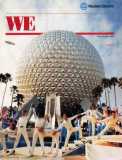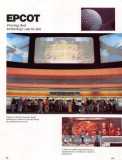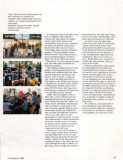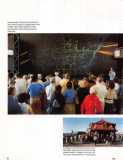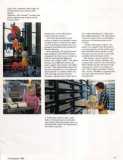[img]Visitors to the Bell System’s Earth Station get a chance to use the World-Key Information Service.[/img]
[img]A musical exhibit depicting the Age of Information entertains a visitor to FutureCom.[/img]
[img](Top): The Fountain of Information is the centerpiece of FutureCom.[/img]
[img](Middle): This walkthrough maze for children is a large representation of a microchip.[/img]
[img](Bottom): Interactive video “games" explain communications technologies.[/img]
A young man, deep in thought, leans over a computer that looks like a commercial video game. His fingers tap the sides of the screen as he contemplates his next move. Suddenly, he smiles and strikes. Using the keyboard below the screen, he types, “Peter Piper picked a peck of pickled peppers.” He grins defiantly, stands back and waits. “Peter Piper picked a peck of pickled peppers,” warbles a deep voice from within the screen. “That’s great!” says the surprised young man. He walks away, somewhat defeated but amazed.
This talking computer, known as the Phraser, is an Interactive Electronic Display that combines Bell Labs’ latest speech synthesizer and newest software in order to make a computer “say” almost anything typed into it.
The display is one of the many features of FutureCom, the Bell System exhibit in Walt Disney World’s newest theme park, EPCOT Center—the Experimental Prototype Community of Tomorrow —in Lake Buena Vista, Florida.
Other electronic games in the exhibit offer a look at Western Electric manufacturing processes and products. Visitors can take the “wheel” of a Chip Cruiser and battle contaminants that can destroy a microchip or test their memories against Western’s newest memory device, the 256K RAM that can hold 256,000 bits of information on one chip. They can also participate in a demonstration of video teleconferencing or obtain information about the current events in 50 states by using a touch sensitive television screen in front of a giant telecommunications network map.
FutureCom is one of several pavilions a visitor reaches after traveling in the Spaceship Earth, an 18 story geosphere that was presented by the Bell System. Visitors to the spaceship are transported back to the Stone Age and, then, through the magic of Disney engineering, travel through the history of communications. The ride ends with a journey into space and through a simulated telecommunications network.
As visitors leave the Spaceship Earth, they enter EPCOT’s main information center. Earth Station, also presented by the Bell System. Beyond Earth Station are 500 acres dotted by pavilions devoted to the themes energy, transportation, agriculture and imagination. There is an entire section—World Showcase—designed to exhibit the achievements of the nations of the world.
Visitors considering a walk around the sprawling Center should wear comfortable shoes. However, there is no need to carry a guidebook. In Earth Station, and throughout the Center, information on attractions, special events, shopping areas and restaurants can be obtained through an electronic information retrieval system known as WorldKey Information Service (WKIS). Developed by Bell Labs and Western Electric, in cooperation with the staff of Walt Disney World, WKIS allows visitors to obtain audio visual information, in Spanish or English, simply by touching certain pictures on a television screen.
The system is a demonstration of how Information Age technologies such as software, lightwave and microelectronics can be used to combine voice graphics, text and video communications in one information system retrieval system.
[img]Periodically, FutureCom’s mural of the United States is transformed into a fiber optic light display of the nationwide telecommunications network.[/img]
[img]Located in the World Showcase, this WorldKey Information Service kiosk stands ready to supply arriving visitors with information on attractions.[/img]
[img](Top): The companies that make up the Bell System are listed in this display.[/img]
[img](Bottom): The Nomad™ cordless telephone captured the interest of this young visitor.[/img]
All of the data needed for the system is stored in a centrally located computer that is connected by lightwave transmission facilities that were designed, assembled and installed by Western Electric.
Peter Krawarik, the technical manager assigned to the EPCOT project, explained that there were several reasons for choosing the lightwave system over copper cables. “The fibers that go into a lightwave system are made of glass and transmit only light,” he said. “This makes them immune to electrical interference—an important characteristic to consider when you have the large amount of power needed to operate the Center’s pavilions. Other interference could come from lightning strikes. The Lake Buena Vista area receives the second largest incidence of thunderstorms in the country.
“Another advantage of fibers,” he stated, “is in quality. The information carrying capacity of optical fibers permits broadcast studio quality on the television screens, which is not easily available with traditional cables.”
Jack Kelsey, a senior engineer who worked on the design, assembly and testing of the system at the Merrimack Valley Works said that all reports indicate that the system is working very well. “We’ve had no problem,” Kelsey said. “In fact, WorldKey is getting more use than expected and it’s still performing well.”
[img]A technician checks a laser video disk. A microprocessor-controlled laser beam finds the proper place on the disk and “reads" the information the visitor calls for.[/img]
